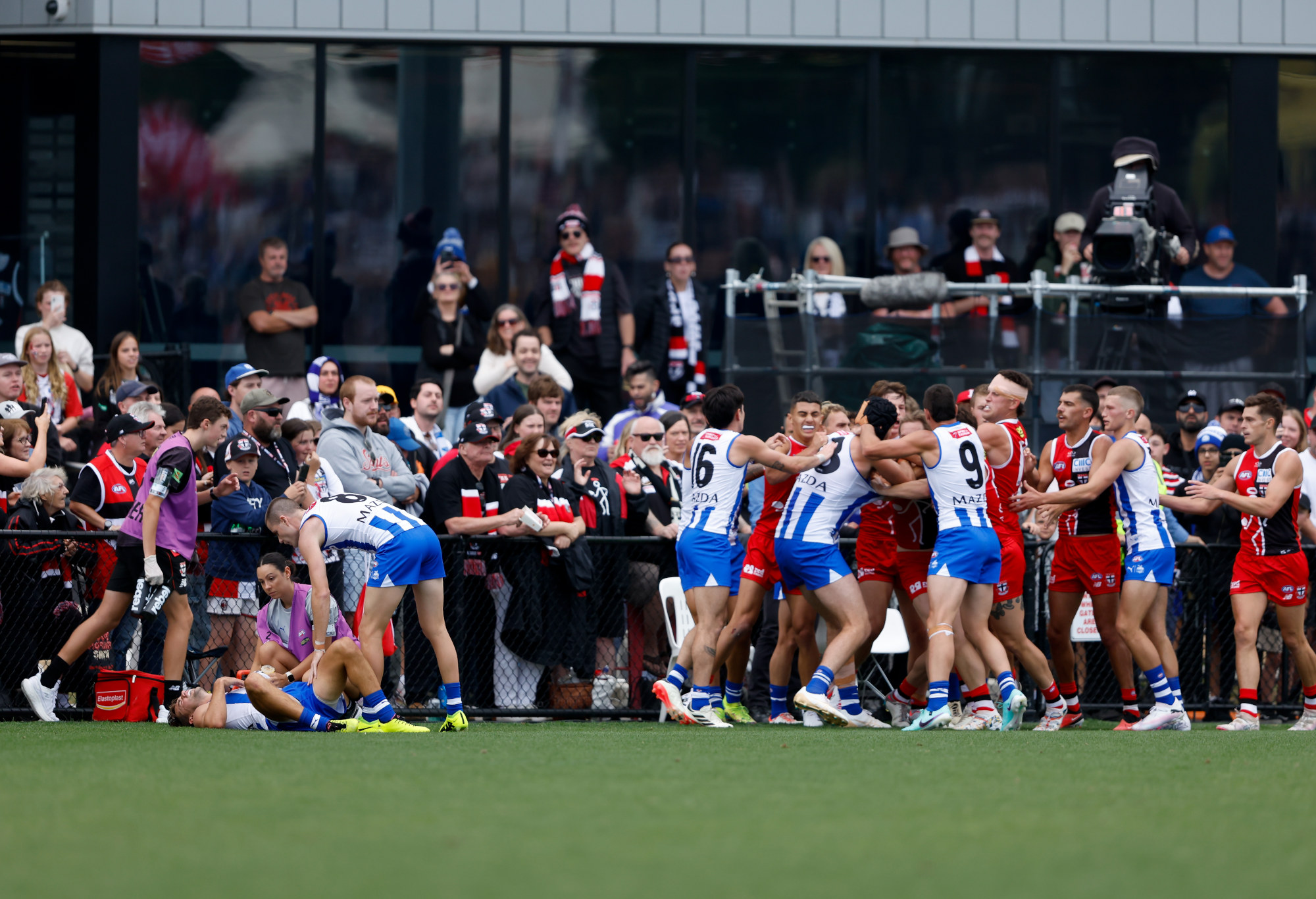It’s not often that I disagree with the great Leigh Matthews, but on this occasion, I am going to bravely take a step into the fire.
Earlier this month, particularly in relation to Jimmy Webster’s pre-season bump on Jy Simpkin, the four-time premiership-winning coach and one of the superior minds in the game revisited the send-off rule.
Using the Webster-Simpkin example, he explained on 3AW:
“Once Simpkin has been removed from the game (under injury/concussion protocols), this should trigger an investigation from the ARC, which has plenty of vision. It would show Webster’s contact was an illegal high-contact bump. Once you’ve assessed that at the ARC level, then they can inform the fifth umpire on the bench or interchange area of their findings and the fifth umpire can view the vision. If the ARC and the fifth umpire agree the send-off rule should be invoked, then Webster is removed from the field…As for timing preferably straight away, or after the next goal. But if you want a fail-safe, because you don’t trust the officials…wait until the next quarter break and the field umpires to look at the vision.”
While taking an offending player out of the game, thus making it an even 22-on-22, sounds good in theory – as he went on to explain, this would only happen a handful of times in a season.
However, while Matthews’ suggestion is sound in principle, it will undoubtedly bring about more problems than it solves.
For starters, why do we need to reinvent the wheel for something that by his own admission is an irregularity?
The AFL already have enough rules and regulations when hits and tackles go wrong – maybe just needs to enforce them ‘better’ and clearer.
Football, or soccer, is going through the same argument with yellow and red cards – and the new proposed sin bin. Ange Postecoglou recently noted that proposed changes would lead to game-day officials having more to think about and splitting hairs in terms of what constitutes the threshold for a sin bin, compared to previously readily apparent sanctions.
With the game getting quicker, umpires need more simplicity, not more to think about.
What happens if there is a divide among the four umpires as to whether a hit is worth a sending-off? Would it be a majority rule, or does it need to be unanimous – can one sole umpire prevent a player from being sent off – and will the closeness of the ‘vote’ be publicly known?
All this, and more, would need to be considered for a send-off rule to be implemented – for me, it’s far too complicated and unnecessary to pursue.

(Photo by Dylan Burns/AFL Photos via Getty Images)
I can’t see Matthews’ idea achieving the desired outcome of stamping out illegal play in the first place; rather, it would add to the already crazy mid-week media circus pile-on that happens in between rounds.
Imagine if a player was controversially sent off, and his absence caused a dramatic turnaround in a game. Kane Cornes would have a field day.
If this was happening every week then perhaps a drastic change is needed, but not for “one or two” times per season, in Matthews’ own words… especially as removing a player from an Aussie Rules contest can have a huge game-changing impact, far bigger in my view than in most other codes taking place on a smaller playing surface with offside rules in play.
Are we actually prepared for officials to get these calls wrong and send off a later-proved “innocent” player?
There will always be disagreement, just like some people will always be baying for Brayden Maynard’s head for his collision with Angus Brayshaw. Removing players from games will just create more division.
I can also see the result being more like the ‘arms up’ umpire dissent rule a few seasons ago – more a propaganda-driven campaign from the AFL trying to send a message, but not proving very successful in changing behaviours – you still see clear frustration from players when calls go against them.
A better option for a radical rules overhaul, in my opinion, is to just make punishments more severe, streamlined and consistent for bad behaviour – so everyone is on the same page.
The AFL simply must tweak the Tribunal process. We can’t have outside experts like lawyers and biomechanical body experts going in and dominating proceedings, trying to freeze-frame analyse or guess in the cold light of day what was going through a player’s head, with the sole purpose of getting his punishment downgraded.
Even more ridiculous are the minutes of statements about a player’s character throughout his junior/high school days. This is just legal teams constructing legal arguments with so much irrelevant information to a footy game and is counterintuitive to changing behaviour, especially if players always think they will have an ‘excuse’ to get out of it at the end of the day.
Take each incident on its merit, and make suspensions fit the degree of severity that you want the action stamped out of the game, and don’t allow for the nit-picky mitigation loopholes.
But making these decisions in the cold light of day, with time to think and with all available replays, is a far cleaner method than putting game-changing power in the hands of an umpiring department that already has more than enough to be getting on with.
Yes, you may say Webster being suspended for seven matches for the Simpkin bump shows the system works, but the fact that he, and other players, are still taking the risk shows efforts to proactively change attitudes aren’t working.
For so little potential application of the send-off, there will be huge changes and ramifications for all involved every time a bump occurs. It would be far better to focus on altering things that will actually change player actions and make the game safer – and it’s this that should be at the heart of any future rule changes.





























































































